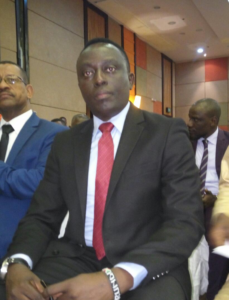By Landry Niyonzima
Almost every day, bodies show up in the streets or in the rivers around the country. In most cases they are not identified, and the authorities do nothing to find out who they are. Local authorities hasten to bury them without dignity or ceremony, making it difficult to know if crimes were committed, and who the authors might be.
Pacifique Nininahazwe, a civil society activist who leads the Ndondeza campaign, remarks wryly that many other people in Burundi meet fates worse than turning up dead and unidentified: they just disappear.
The Ndondeza (help me to search) campaign documents cases of enforced disappearance, publishes them and communicates them to the relevant institutions. Last year alone, Ndodeza investigated 28 cases of enforced disappearances, an average of two a month. Several cases of enforced disappearances were recorded in two of the 18 provinces of Burundi.
After Burundi began its descent into a deadly political crisis three years ago, at least 1,000 people are estimated to have been killed, another 400,000 displaced into exile, and an unknown number have disappeared without trace.
Launched in April 2016, the #Ndondeza campaign has already documented 107 cases of enforced disappearances. “When we say that we have documented 107 cases, it does not mean that since then there have been only 107 cases of enforced disappearances. No. It is the cases on which we have done investigations and about which we have published the results, that can be seen on the website www.ndondeza.org,”
Pacifique Nininahazwe explains. “We publish when we have collected — all the information available on the case, be it information from close family that allows identification, information on when they have noticed the disappearance … Then we look at all the information that has been in the press. We have ‘internal sources’, sometimes informers in the national police, in the national intelligence service, or anonymous witnesses who write to us, who say yes, we know this case, we were witnesses, we were on the spot, we know what has really happened.”
The Ndondeza campaign has been alerted about 300 cases, which it continues to investigate. “Among the 107 cases that we have already documented, the majority of victims are activists of opposition parties, mostly members of the Movement for Solidarity and Democracy (MSD) led by Alexis Sinduhije, and activists of Agathon Rwasa’s National Liberation Front (FNL).” There are also former army servicemen (former Armed Forces of Burundi), the majority of whom are Tutsis, and some military staff formerly of the National Liberation Front (FNL). Some former Forces of Defence of the Democracy (FDD) and Imbonerakure militiamen are also listed among the disappeared after refusing to commit crimes. Many of the individuals who are disappeared are potential witnesses about the crimes that have been committed, or as they are considered close to the opposition and dissidents from the ruling party CNDD-FDD (National Council for the Defense of the Democracy – Forces of Defence of the Democracy). Everything is done to cover up and prevent knowledge of the crimes that are currently being committed in Burundi, says Ndondeza’s chief. “So it is all a set up to prevent that the authors of the enforced disappearances are known. That the crimes are known,” he notes. Once a body has been found, Ndondeza does not refer to it as an enforced disappearance but rather as an extra-judicial execution. “
In most of the cases, the bodies have been hastily buried, without any sanitary measure or examination by a coroner. There are no public announcements that a body has been found, giving a description so that families who are missing a loved one can come and check if it is a member of their family,” says Pacifique regretfully. In certain situations, alerts on social networks have saved lives. “When people are arrested or kidnapped and we launch alerts as quickly as possible, it has been possible to find them.” Victims who disappeared and reappeared say they were in dark places, not really knowing where they were, but after alerts went out, for example on Twitter or Facebook, the kidnappers realized that they had been exposed and finally let their victims go. In the majority of the cases, the author of the enforced disappearance is more or less known. But there are also many cases where the perpetrators have not been identified. These are cases where policemen or intelligence agents come in official pickup trucks known for their dark windows. “In such a case, we have an idea that it seems to be an intelligence operation, but we don’t know the author of the disappearance. In most cases we finally found the kidnapper or the person who ordered the kidnapping or arrest operation,” he explains.

Between 2015 and 2016, at the height of the Burundi crisis, many victims were arrested in front of their families, their friends, and fellow activists. People would be arrested at home or during demonstrations in public places, seen by witnesses.
In 2018, the victims were often called for a meeting, in a random house, in a place where there are no witnesses. “We only know the person that has called, but we don’t know what happened then. We know that the person has answered the call, and afterwards, one cannot find that person any more,” Pacifique says. Ndondeza points an accusing finger at the National Intelligence Service (SNR), which is controlled by the presidency, the national police, the army intelligence agency, and the Imbonerakure militia that cooperates with certain local authorities for the enforced disappearances. “We have also noted that the Burundian intelligence agency, the Burundian police, the Burundian authorities have ordered the mobile phone companies not to facilitate the providing of the phone logs of the victims any more.”
Mobile phone companies are often reluctant to provide the phone logs of a victim of enforced disappearance unlike in 2015, 2016 and 2017. In all the cases documented by the Ndondeza campaign, the bodies have never been seen. ‘That is why we, like the loved ones, the families of the victims, continue to ask the Burundian authorities to tell what has happened to the people arrested or kidnapped by the SNR.”
“For the families it’s very hard. They don’t know if they should continue to wait for the victim to come back, or start the mourning process and say: it’s over. We will not see him gain. The family is torn between the hope of finding their loved one and the despair of believing that it is over, the person is dead. The family does not know whether to mourn or to wait,” concludes Pacifique.







